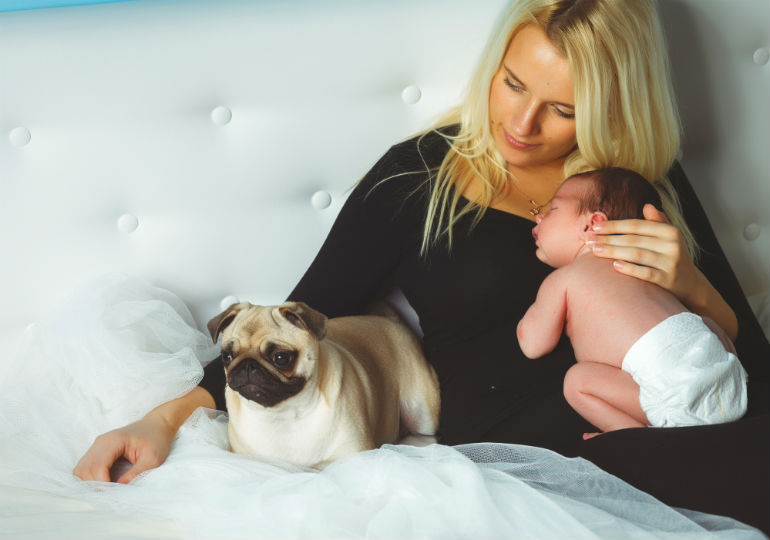When you bring home a new baby, what’s exciting for you and your spouse can be confusing and even frightening for your dog. Think about it: That little baby seems like a human, but it smells, sounds, and moves like nothing your pet has ever seen before. And suddenly this strange, loud creature is taking up all of his owners’ time and attention.
Dogs can be eager learners, but they can also exhibit jealousy because they are no longer the center of attention. But by planning ahead and taking the right steps in the first few weeks of your baby’s homecoming, you can help create a bond between your new addition and her four-legged older sibling. Here’s how:
Get your dog ready before the baby comes home. This includes a basic obedience class to make sure your dog does not jump; understands sit, down and stay; and develops a solid recall so he comes to you when you call.
- Make gradual changes to your dog’s routines—such as a change in where the dog sleeps or when he gets walked —before the baby comes home, so that the dog will not associate the changes with the baby. Go through the baby’s routine before the baby arrives, including changing, feeding, rocking and walking with an empty stroller.
- Lessen the amount of play and attention you give your dog two to three weeks before the baby comes home. You do not want to “last minute” lavish your dog with affection, only to have it stop when the baby comes home.
- Play a tape recording of various baby sounds in your house for increasing lengths of time so your dog can adjust to the new sounds before you bring the baby home.
- Acclimate your dog to baby smell, including lotion, powder, etc. Once the baby is born, bring an article of the baby’s clothing or a baby blanket home so the dog can get used to the infant’s scent.
- Before baby arrives, teach your dog to “go to place.” You can use any mat, bed, or defined area to teach this behavior, and it is easily transferred to other locations. Stand beside the bed or area you want your dog to go. Point to the area, praise as soon as your dog is on his place, and reward with treats. Use a release command like “Okay!” and toss a treat to encourage your dog to come off the mat. When your dog learns where his place is, add a sit or down. Use “place” to mean go where I point and then sit or down. Gradually increase the length of time the dog stays on the bed and give your dog something rewarding on his place, like a chew toy.
- When you arrive home with the newborn, first greet your dog alone so it doesn’t get excited and jump on the baby.
- Allow your dog to adjust to the smell, sight and sound of the baby for a few days before introducing them in closer proximity.
- After a few days, allow the dog to sniff the baby while controlled on a leash. Pet him and give him praise while he sniffs. Most dogs adapt easily, but always take precautions. Always allow the dog to approach you and the baby. Allow the dog to choose to interact with the baby. Invites prevent bites.
- Once your dog is used to the baby’s smell, allow the dog to sniff the baby off leash.Your dog may react differently if the baby suddenly screams, cries or kicks and interpret these signs as an invitation to play or as a warning. When interacting with the dog and baby, keep the baby elevated and make sure an adult is between them at all times. Dog-adult-baby seating order.
- Give your dog plenty of attention when the baby is around. You don’t want him to decide good things only happen when the baby isn’t around.
- Don’t scold the dog for picking up the baby’s toys. You don’t want the smell of the baby being associated with anything negative. Simply replace the child’s toy with the dog’s toy.
- Babies change quickly, and it can be difficult for the dog to adapt as quickly.
- Once your baby begins to crawl, make sure that he/she doesn’t pull on the dog’s tail or ears. Snapping and growling are natural canine behaviors when they are trying to communicate a warning. Even the most tolerant dog has its limits!
- Never leave even the most trusted dog alone with a baby or small child!
- Have “safety zones” for the dog. A safe zone is a private space – a crate, a bed, a gated laundry room, etc. where he or she can get away when the activity is too much for him or her. Children should not be allowed to “invade” the dog’s private space.
- It is OK to keep the dog out of the baby’s room with a gate, etc., especially if he is curious and attempts to jump on the crib or changing table.
